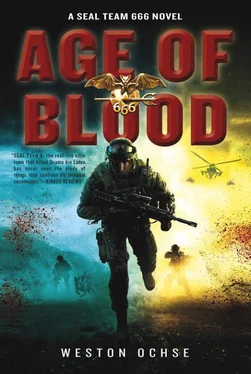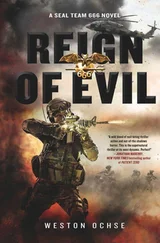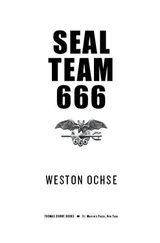“So the temple area that makes up the Templo Mayor on the surface was the primary temple of Tenochtitlán,” Jen told them. “The pyramid that all the tourists see is the remains of the Grand Temple of Huitzilopochtli. He was the god of sun, war, and human sacrifice and was the patron god of Tenochtitlán. But his wasn’t the only temple. The Aztecs worshipped many gods, goddesses, and beings, many of whom have made it into popular culture, much like Our Lady of Guadalupe, who is also the mother goddess Tonantzin.
“The stone statues on top of these smaller buildings are chacmools. They’re actually Toltec icons, pre-Columbian, and date back to around 500 AD. They are heavily prevalent at Toltec sites such as Chichén Itzá. Their appearance here indicates the worship of some lesser god which transcended and survived as one Mesoamerican belief system imposed itself over another.”
“Do we know what or who they represent?” Walker asked.
“Could be a corn god. Could be Santa Claus. I have no idea.”
“What about the temple?” Yank asked. “Looks like some of our friends are camped out on top.”
Jen shook her head. “It’s of classic construction but not overly large. Without looking at the iconography on the sides, I don’t know. See there at the base of the pyramid?”
Walker saw a rectangular area standing about the height and width of a man, with round objects lined up next to each other and stacked atop each other.
“That’s a skull rack. Those who have been sacrificed have their heads placed there to remind everyone of their gift to the goddess.”
“Oh, joy,” Walker said, grimacing.
“You said ‘goddess,’” Yank pointed out. “Does that mean you know?”
“I don’t… maybe I do. I only just recently become an ‘expert,’” she said, laughing awkwardly. “I’m just trying to make sense of what I studied. Hold on a minute.” She dialed up some information on the tablet, read for a moment, then returned to their shared view. “With the snakes and the smallish pyramid, it could be the temple of Cihuacoatl. It would make a certain sense. The Cihuateteo are her followers. Cihuacoatl is a mother goddess. She’s a fertility goddess too. It’s believed that along with Quetzalcoatl, she ground up the bones of the previous peoples to create the current human peoples.”
“What would Los Desollados be doing on her temple?” Walker asked.
“Good question,” Yank added. “Xipe Totec, was it?”
“Right. Los Desollados are worshippers of Xipe Totec.” She checked the information on the tablet once more, then snapped her fingers. “See the shadows in front of the rectangular building on the right?”
Walker and Yank nodded.
“Xipe Totec’s temple is underground. I believe those are entrances. They called it Yopico, or the place of Yopi, the Zapotec name for the god. The Zapotecs date back to six centuries before Christ, so like many of the gods, it’s the same god with a different name.”
“You mentioned Itzpapalotl. What does that mean?” Walker asked.
“It translates to ‘obsidian butterfly,’ or maybe ‘clawed butterfly.’ Why?” she asked.
“See the reclining figures, those chacmools,” Walker said, indicating the figures on the mausoleums. “Doesn’t it look like they have protrusions coming from their backs? As if they might be folded wings?”
“Something like a butterfly’s wings?” Yank asked. “Yeah, maybe. What’s the background on Itzpapalotl?”
“She ruled over a realm which is the resting place of dead infants and the crucible for humanity.”
“Seems to fit a theme.” Walker wanted to get a better look at the area. The men arrayed around the main temple couldn’t be distinguished in the picture.
“She’s also a vampire,” Jen said.
“Seriously?” Yank asked, looking up. “Seriously? We got a werewolf and a vampire? What’s next, Creature from the Black Lagoon?”
“Be careful what you wish for,” Walker said, without a trace of humor.
“But I don’t think the temple of Itzpapalotl is here. Even if the chacmools look like them, she’d have something greater than even this pyramid.”
An idea crept into Walker’s mind. “They could be like bishops.”
“What do you mean?” Yank asked.
“In the Catholic Church, if a bishop dies, he gets buried in the cathedral’s crypt with a sarcophagus, usually with a relief of the one who was buried there. I wonder if this might be the same.”
“Like a priest or priestess of Itzpapalotl? Something like that?” Jen asked.
“Yeah, something like that.”
Yank straightened and removed the image from his QuadEye. “Somehow this whole place has the look and feel of a crypt.” He checked his watch. “Let’s get in there. I have enough background to ace a test, but not enough to get out of this alive. Let’s see if we can get some good information from a little reconnaissance.”
“We need to get set before the others arrive, anyway,” Walker said. “I need to make a hide site.”
AQUEDUCT ENTRANCE. MEXICO CITY. NIGHT.
One kilometer south of the plaza stood a man-high gate secured with an old, thick lock. Brown water gushed through it, just above their boots, falling into a trash-laden aqueduct below and behind them. A drunk called out to them, his words too slurred to understand. If he was ever to report them, he’d remember two black-clad men in shiny helmets—aliens—entering the sewers. If the Mexican authorities believed him, and if they decided to climb into the aqueduct, it would be long after the events that were about to unfold, because right now the police were responding to bank alarms signaling from all over town. More than three hundred alarms were being triggered at alternating times, causing every local and federal policeman to rush back and forth, leaving the area around the plaza even more free of police than it had been.
Laws snapped the lock. He and Holmes entered, and then he secured it with a bicycle lock. He tossed the keys up the aqueduct, where they sank. Then they began to move forward, carefully, but quickly. They had a lot of ground to cover.
Without knowing the extent of their underwater travel, they’d opted for the worst scenario, which is why they were wearing a closed-system scuba, with full-body neoprene and a full face mask that also covered their ears. The DARPA-provided mask was constructed from Gorilla Glass and featured an internal head-up display (HUD), which gave them full-spectrum views from the two forward cameras. They wore ballistic gloves on their hands and Vibram Spyridon toe shoes with carbon-polymer-reinforced soles. The latter provided them a much surer grip in the slippery wash on the bottom of the old pipe than anything else they could have chosen.
Pure oxygen was being pumped into the mask, courtesy of the LAR V Draeger rebreather system. Worn with a modified horse collar and a low profile that reduced the bulk as well as the amount of oxygen it provided, it still wouldn’t get in the way of OTB operations with the DARPA mask.
No skin or hair was in danger of touching the vile liquid that was coursing around their ankles. With levels of lead, Diazinon, carbofuran, chlorpyrifos, and malathion more than thirty times that of the most polluted American river, the tests didn’t even take into consideration the molecular biological threats present in the sewer. Although they’d entered into the unknown, they knew that even a drop of the substance would probably kill them, whether it was today, tomorrow, or ten years from now when their bodies were so full of tumors they wouldn’t even have enough space for body fat. The full-body suits were a nod to more than convenience. They were an acknowledgment that they could be killed by something their HK machine guns couldn’t protect them from.
Читать дальше












